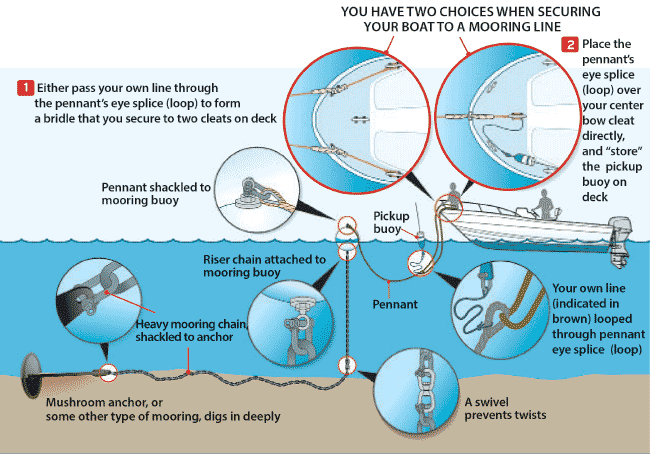
Picking up a mooring is far simpler than docking or anchoring. But many boaters never learn this simple technique and are intimidated to try in close-packed mooring fields. Adding this skill to your arsenal will make weekend jaunts more enjoyable and increase your flexibility when choosing an anchorage. Some simple preparations, good communication, and a bit of coordination will make mooring pickups easy. Of course, some practice never hurts!
HERE’S AN ARTICLE i FOUND BY By Beth A. Leonard
In any commercially maintained mooring field, and even on most private moorings, a large round buoy will be the most visible part of the mooring. The bottom of this buoy, under the water, is attached to the mooring anchor by some combination of chain, line, and fasteners. The line meant to secure the mooring to the boat, called the pennant, may be attached to the top of the mooring buoy, to the bottom, or to the chain beneath the mooring buoy. Unless the pennant is made with floating line, it will be below the water’s surface and invisible as you approach the mooring. To make that line easier to retrieve, there will usually be a smaller “pickup buoy” near the larger mooring buoy. This can range from a small, round float to a cylinder with an antenna-like wand from the top, tall enough to be reached from the bow of the boat. All you must do is retrieve that mooring pennant and attach it to a strong point on the bow.
To secure your boat to the mooring, follow these six steps.
- Get ready. As you enter the harbor and while you’re trying to identify the mooring you need to pick up, a crewmember should take a boat hook and a short (6-10 feet) length of line to the bow. The line should be the size and strength of your docklines, large enough to hold the boat but small enough to double on a bow cleat. Secure one end to a bow cleat and run the other end through a fairlead, if your boat has one.
- Get positioned. Once you’ve identified the mooring you want to pick up, determine the direction of the wind. Approach the mooring from dead-downwind, which means the bow is pointing into the wind.
- Approach the mooring. Head toward the mooring slowly, with just enough throttle to keep the boat moving into the wind. The crewmember on the bow should continually point at the mooring with the boat hook. The movement of the boat hook and its angle will give you a good idea of how quickly you’re approaching. At the same time, the crew on the bow should indicate the distance to the mooring in boat lengths, not in feet. It’s easier to estimate one or two boat lengths than 30 or 60 feet. On smaller boats, they can call out the number; on larger boats, hand signals work better.
- Stop the boat. Before the bow comes to the mooring, put the engine in neutral. Unless the wind is strong, the boat’s momentum will carry it forward a bit before the wind starts pushing it back, giving the crew on the bow time to retrieve the pickup buoy.
- Retrieve the pickup buoy. If the buoy has a long “antenna” on it, that the crew can reach from the bow, perfect. He/she should just pull it aboard. It will be attached to the pennant, which usually will have a loop that can be secured to your bow cleat. If the buoy doesn’t have an antenna, or if the bow is too high to reach it, use the boat hook to grab the line attached to the pickup buoy. Better yet, if you can see the line attached to it, hook that anywhere along its length, and the boat hook will slide to the pickup buoy and stop. If you miss, let the wind back you away so you don’t foul your prop and try the maneuver again.
- Secure the boat. As the pickup buoy is pulled aboard, the crewmember will be able to see the size and condition of the line attached. Most mooring pennants have a loop (called an “eye”) spliced into the end for putting over a boat cleat. But mooring lines are often oversize and may be too big to fit on the cleats of smaller boats. They can also be covered with mud, seaweed, or slime that you’d rather not get all over the boat. Your crewmember can quickly decide if it will fit through your fairlead, in which case he/she can just do so and then drop it over the cleat, and you’re secure. Or, if it’s too big or too dirty or too fouled with barnacles, just take that extra line that was secured to the bow cleat, quickly run it through the eye of the mooring pennant, and then take that line back through the fairlead and to the opposite cleat. That way, you secure the boat without covering the bow in green goo.
If anything goes wrong, just let go. No harm done! Release the mooring, let the wind blow you clear, circle around, and take another shot.